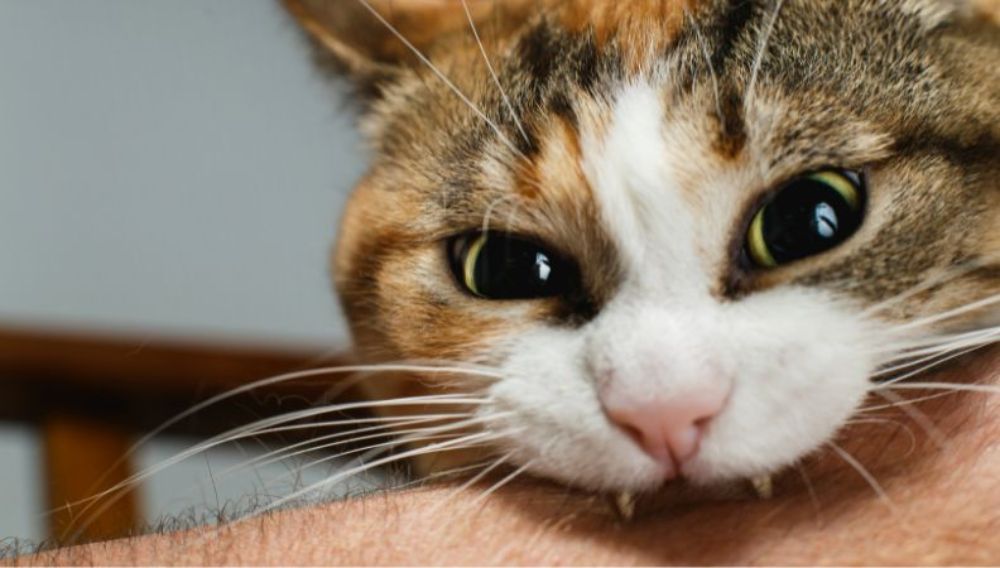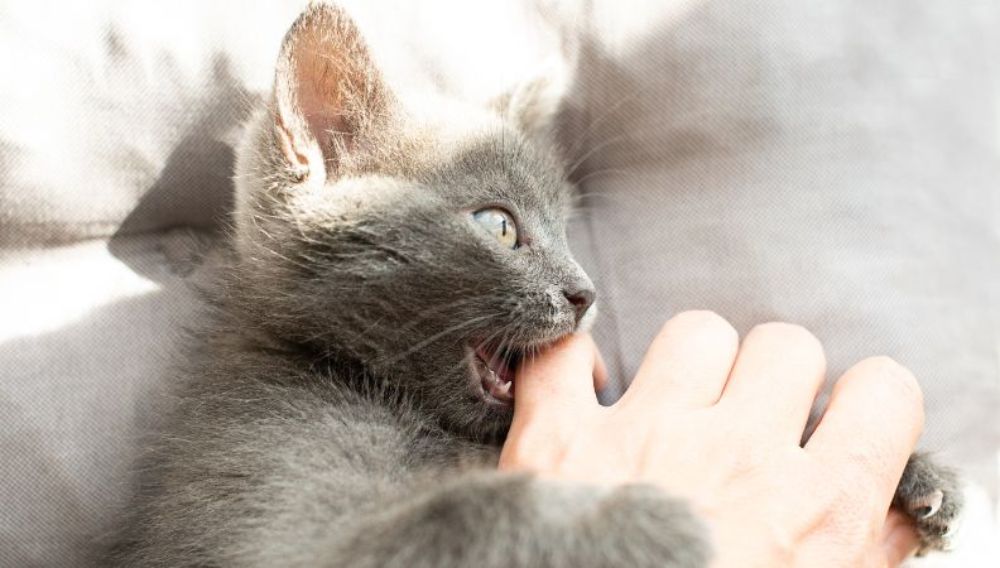
Cats may bite for a variety of reasons, and it’s not always down to aggressive cat behaviour, sometime it is just natural instinct. Understanding the different types of bites and why your cat is biting can help reduce the risk of cat bites. So we've put together this guide that owners of our feline friends can follow, and get to the bottom of the age old question... Why does my cat bite me?
The Lowdown on Cat Biting
Cats usually bite for two main reasons. Either out of fear or if they learnt an inappropriate way of interacting with their owner as a kitten. If a kitten hasn’t been well socialised at a young age (from around 2-8 weeks), young cats can feel threatened by contact with people. Because of this they’ll show fear aggression, a behaviour that can continue into adult life.
Chasing, pouncing and biting are all natural cat behaviours. Adult cats usually learn bite inhibition as a kitten. This is when they're taught not to bite too hard by their mum and siblings. If kittens bite too hard when playing, play will stop and will only continue if they bite gently.
If your cat play biting you, don’t shout or punish your cat, just stop the play for a while and then start again when they’ve calmed down. They’ll soon understand the rules of play!
If your cat likes to ambush you or bite at your fingers and toes, they may have learnt this behaviour as a kitten. If you allowed your cat to play with your hands and feet as a kitten, they would have assumed this ‘play’ was acceptable! Playing like this then continues as an adult. And if you ran away and yelled, the more this predatory behaviour would have been reinforced.
Cat owners often ask, why does my cat bite me gently? Gentle bites may be a sign of affection or a sign they want to play. Another type of bite is the love bite when your cat licks and nibbles you! These bites don’t hurt or break the skin and are a sign that you’re part of their family.
Sudden biting is when your cat turns and bites you out of the blue after a petting session! It may mean that the cat has had too much stimulation and wants you to stop. It sometimes happens when their tummy is rubbed. The biting may be preceded by some clues in their body language, watch out for a swishing tail, ear flattening, dilated pupils and a tense body.
It’s also worth mentioning bunny kicks, in the wild it's used in hunting and fighting, but in the home it's not acceptable behaviour. A cat bunny kick is when a cat uses their hind legs to kick out, usually after wrapping their front legs around your arm and then kicking you with their hind legs. They may use their claws and bite as well. When your cat starts to bunny kick, distract them with a cat toy and gently push them away.
If you notice that your cat bites you whenever you touch a particular area, they may be biting because they’re in pain. Book a vet appointment to check for any underlying health problems.

What are the Warning Signs My Cat is Going to Bite Me?
Understanding your cat’s body language is key! If you understand when to approach a cat and when to leave a cat alone, you should be able to avoid a cat bite. So, keep a look out for these warning signs:
- Avoiding eye contact or staring at you
- Dilated eye pupils
- Ears flattened against the head or held back
- Body posture with head held down
- Piloerection when the fur on their spine and tail is raised
- Tail swishing back and forwards or flicking
- Hissing or growling
How to Treat a Cat Bite
As cute and fluffy as your cat may be, they can inflict serious injuries if you’re not careful. They have very sharp teeth that can cause deep puncture wounds. They can also pass on bacteria, so always wash a cate bite wound with soap and water. If the area around a cat bite becomes hot, swollen, oozes or becomes filled with pus, then the wound may be infected and you’ll need antibiotics to treat the wound.
Another infection that cats can pass on to humans is a bacterial infection known as cat scratch disease (or bartonellosis after the Bartonella bacterium responsible). This cat bite infection can lead to a flu-like disease, especially in people with suppressed immune systems. If you have an infected cat bite, always seek medical treatment.
How Do I Stop My Cat Biting and Attacking Me?
Recognising the signs that your cat is unhappy, bored, angry or in pain can reduce the risk of your cat biting you. Some cats can only take a limited time of petting before they become over-stimulated. They’ll soon let you know they’ve had enough but others demand their owners to be paying attention more.
Always make sure your cat has lots of toys to play with, places to hide and a scratching post to keep them amused. Some cats like to have a companion cat (or dog) to play with.
If your cat is biting your hand or arm and won’t let go, try to keep calm and don’t pull away to get them to release. This can result in them biting harder! Instead, push towards the cat and never shout or punish your cat for biting. Try redirected aggression by giving them a toy to play with and praise them when they play with it.
Always teach children to play gently with cats and not to chase or restrain them. Teaching children the warning signs too to help them understand when to play and when not to leave them alone.
There are different types of cat bites, ranging from gentle bites and love bites to sudden and aggressive bites. Understanding your cat’s body language, how they’re feeling and the message they’re communicating can help stop cat bites. It will also make the bond between you stronger.
Cat’s teeth and claws that break the skin can cause infection. Always wash any cat bites with soap and water and seek medical advice on cat bite treatment. If you're concerned about aggressive cat biting, ask your vet to refer you to a cat behavioural specialist.
Everypaw Cat Insurance
Everypaw's Cat Insurance comes with 24/7 unlimited access to vets and vet nurses that can help with your pet's health, care, nutrition and behaviour. So you can rest assured your kitty will be well looked after.
Content provided from Vetstream's Vetlexicon Felis - www.vetlexicon.com/treat/felis
Vetlexicon is the world’s largest peer-reviewed online clinical reference source. All our content is written and peer-reviewed by over 1,000 of the world’s leading veterinarians, ensuring relevance, accuracy and quality.
- Jenna Kiddie & Vetstream Ltd (online) Aggressive cats. In: Vetlexicon Felis, Vetstream Ltd, UK. Website: https://www.vetlexicon.com/treat/felis/client-information/aggressive-cats
- Vetstream Ltd & Rosanna Marsella (online) Cat scratch disease. In: Vetlexicon Felis, Vetstream Ltd, UK. Website: https://www.vetlexicon.com/treat/felis/client-information/cat-scratch-disease
- VetFolio & Vetstream Ltd (online) Aggressive cats – tips for interpreting signs. In: Vetlexicon Felis, Vetstream Ltd, UK. Website: https://www.vetlexicon.com/treat/felis/client-information/aggression-tips-for-interpreting-signs